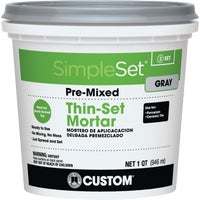
In addition to the material is the way it is applied. Most bonding compounds that are used to apply tile must be used with a notched trawl which will cause voids between the material that are used for leveling the tile and match the correct amount of bonding agent to the tile. In general the larger the tile the larger the notch so a 3×3 inch tile used for decoration may only need an 1/8th inch notch but a 1 foot square tile will need a half inch notch. Keep this in mind when apply your material.
When picking a bonding compound you want to ask the tile material supplier if there are any suggestions or warnings for the type of tile you are installing.
This is very important when working with stone. If you use a petroleum based adhesive when applying stone you can have bleed through which will discolor the stone from behind.
For normal ceramic tile you have a wider selection of products you can use without worrying about bleed through.
Thinset Mortar
Thinset Mortar is one of the most common bonding compounds for applying wall and floor tile. This product normally comes pre-mixed dry in 1 to 5 gallon containers and may require you to add a polymer agent at the time you do the final mixing.
Thinset is a material made out of sand and cement and this means you do not need to mix your own sand and cement as in mortar beds. You will need to add water at a minimum to activate it and then it will stay good to use for an hour or two depending on your humidity levels.
When you apply the material use a notched trawl and then after setting the tile clean the surface with a rag or sponge. Make sure to leave good grout joints that are clean so you won’t have to pick out the thinset while grouting.
Mortar Beds
When you are installing ceramic tile over a substrate that requires buildup such as a bathroom shower floor you can mix your own mortar bed material out of 1 part portland cememnt to 5 parts sand. This is good if you know the sand you are using does not have stones in it but most sand available at home centers even in the cement isle is play sand that is used for kids sand boxes and it will contain many stones that you do not see. If that is all that is available then you will have to put the sand through a screen to get the pebbles out.
You mix mortar to a dry mix so it should not look like you are applying frosting to a cake it should look like you are building a sand castle at the beach with sand moist enough to hold its shape.
The cement in a mortar bed will need to be washed down after you place your tile and this will finalize the reaction and cause it to harden.
If you are a beginner I strongly suggest you buy bags of pre-mixed mortar.
Mastic Adhesive
Mastic is a caulk like material that can be used in limited areas for decorative tile. Normally you do not want to use this product in any area with high water or moisture such as a tub or shower surround but it can be used on bathroom and kitchen walls.
It comes in a pre-mixed ready to go tub from a quart to 5 gallon sizes. You can also buy it in a tube.
I have even just used caulk in some areas to attach tile if it says it is also an adhesive. I would not suggest that you use silicone caulk in any application of tile.
Final Note
Remember ask your tile provider what type of bonding agent is suggested for your project.
Never try to make repairs with a material not matched to your install such as fixing a shower tile with mastic or caulk because it will fail.
Manufacturers are happy to provide literature with their tile to help you make the right selection of bonding agent and the tools required such as picking the correct notch trawl so ask when you buy.
